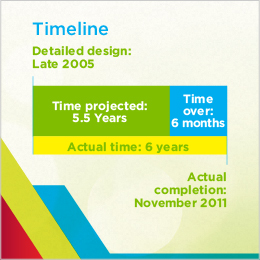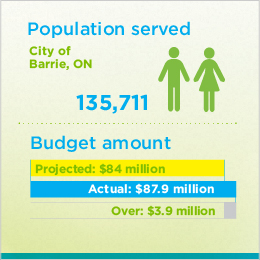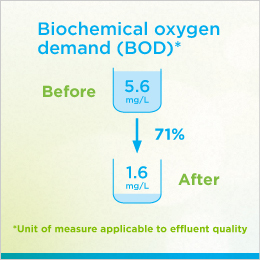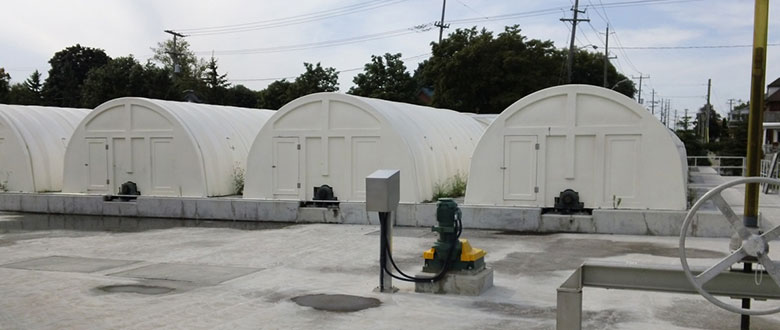This is part of a series of case studies on wastewater projects funded by the FCM's Green Municipal Fund. Each case study provides technical information, project details and tips on best practices.
Project overview
The City of Barrie, ON, expanded its wastewater treatment plant to accommodate municipal growth and improve the quality of water flowing out of the plant and into the environment. The project expanded the plant's capacity for water pumping, biological treatment, solid separation, disinfection, sludge digestion and beneficial use of biogas. The city also added a new anoxic selector tank.
These upgrades have reduced the amount of phosphorus in the wastewater and helped to maintain acceptable levels of ammonia. The upgrades have also increased the plant's production of biogas, which is used for on-site generation of electricity to reduce energy costs. In addition, the project has contributed to the continued protection of Kempenfelt Bay and Lake Simcoe.



Reasons for the project
- The city needed to increase the capacity of its wastewater treatment plant to support community growth and minimize combined sewer overflows.
- The system also needed upgrades to ensure that effluent would meet the standards for ammonia and phosphorus loadings set out in the Lake Simcoe Protection Plan (2009).
Innovative aspects of the project
- Barrie's wastewater treatment plant is the largest point of discharge in a sensitive, freshwater environment.
- This project has contributed to the ongoing restoration and protection of Lake Simcoe.
Best practices and key lessons
The municipality's experience with this project demonstrates some best practices and key lessons that can inform similar projects.
Conduct background research
- One lesson learned was that the project would have benefitted from additional research on regional environmental trends and requirements, such as more stringent standards for phosphorous levels and effluent.
- By consulting with regulators and interest groups, including conservation authorities, the city engaged stakeholders to learn how others were tackling these issues and what new technologies were available to treat phosphorous.
Optimize long-term returns on investment
- The city undertook a value engineering process with the successful bidder to identify opportunities to improve the project design and reduce costs.
Use alternatives to lowest-bid procurement
- The city's engineering department and the design consultant worked together to pre-qualify bidders and used a quality-based selection process to evaluate the bids (versus using a lowest-bid procurement method).
- The city pre-selected major equipment, including raw sewage pumps, tertiary filters and UNOX tank mixers.
Use effective communications and project management
- Barrie's wastewater operations group was involved throughout the planning, design and commissioning of the upgraded facility.
Prepare detailed testing and commissioning work plans
- Detailed testing and commissioning work plans should be developed during the early stages of a major project.
- During the design process, the project team worked to identify potential shutdowns that would cause service disruptions.
- Project timelines should reflect the time required for biological processes to become established and respond.

Rotating biological contactors installed to reduce ammonia and organic nitrogen in Kempenfelt Bay (City of Barrie, ON).
Project benefits
This project yielded a number of environmental, social and economic benefits.
Environmental benefits
Reduced energy consumption (electricity and natural gas): The city added variable frequency drives, which ramp up and slow down motors depending on requirements, reducing electrical demands.
Renewable energy generation: The plant generates more biogas as fuel because it is treating more wastewater. This allows boilers and co-generation engines to run more consistently (rather than intermittently) to generate heat and electricity for various treatment processes and winter heating.
Improved effluent quality: The city is able to comply with more stringent effluent treatment requirements. Effluent quality meets the Environmental Compliance Approval (ECA) targets set by the Ontario Ministry of the Environment and Climate Change. For phosphorus and ammonia, the targets are 0.18 mg/L and 4-10mg/L respectively (monthly averages).
Decreased municipal water consumption and improved stormwater management: As part of this project, the city implemented several complementary programs to help reduce the treatment plant's wastewater inflow load. These included a comprehensive inflow and infiltration (I&I) program, a low-flow toilet rebate program and a review of illegal roof drainage systems and downspout connections.
Improved odour control: The city added a new biological odour control unit to treat air collected from the truck loading station, sludge blending tanks and sludge holding tank.
Social benefits
Improved staff health and safety: The facility was nearing its hydraulic capacity, and therefore the equipment and tanks were nearing their capacities. Expansion of various process tanks has improved operators' ability to make small adjustments over longer periods of time.
The expansion also allowed for tanks to be removed from service for maintenance activities, which ensures continuous service and reduces maintenance closures for the wastewater treatment plant. Permanent cranes were also added to give staff the ability to lift heavy objects more safely; previously they used winches and chains.
Opportunities for physical and recreational activities: The project's new odour control unit has minimized odours emanating from the wastewater treatment plant. This in turn encourages more use of the waterfront.
Promotion of a sustainable lifestyle: The expansion project demonstrates Barrie's commitment to creating a vibrant downtown, managing growth through intensification and protecting the environment and health of Lake Simcoe.
Public space: A healthy Kempenfelt Bay is a showcase for Lake Simcoe and an important centrepiece of the community.
Economic benefits
Improved conditions for tourism: A cleaner waterfront increases the city's ability to attract tourists, who generate revenue for area businesses.
Support for economic growth: The facility's expanded treatment capacity allows for further intensification in the city's land use, creating supportive conditions for economic growth, employment and municipal revenue.
Diverse sources of financing: The city was able to finance this project through revenue from utility rates and development charges, as well as through interim financing, debentures and a Green Municipal Fund grant and loan.
Decreased operating costs: The city installed high-efficiency motors for all pumps and mixers and high-efficiency UV bulbs to make the existing UV system more energy-efficient. The existing hydronic heating system, which uses the wastewater biogas for fuel rather than electricity or natural gas, was expanded, thus increasing energy efficiency.
Extended asset service life: The project expanded the capacity of the existing facility, saving the expense of building a new one.

Technical highlights
Technical highlights are current as of 2013.
Treatment
- Before: Conventional activated sludge
- After: Conventional activated sludge with a UNOX system and rotating biological contactors
Disinfection
- Before: UV disinfection system
- After: The project added a secondary, high-pressure sodium UV system to supplement the existing UV system, which had not yet reached the end of its life cycle.
Biosolids management
Average annual daily flow (AADF)
- Before: 52.9 MLD (million litres per day)
- After: 51.2 MLD
Design capacity
- Before: 57.1 MLD
- After: 76.0 MLD
Per cent of total capacity used for AADF
- Before: 93 per cent
- After: 68 per cent
Total suspended solids (TSS)
- Before: 5.6 mg/L
- After: 1.5 mg/L
Project contact information
Jessica Peters-Palfi
Senior Engineer
City of Barrie, ON
T. 705-739-4220, ext. 4740
Michael Jermey
Deputy Treasurer
City of Barrie, ON
T. 705-739-4220, ext. 4751
Want to explore all GMF-funded projects? Check out the Projects Database for a complete overview of funded projects and get inspired by municipalities of all sizes, across Canada.

